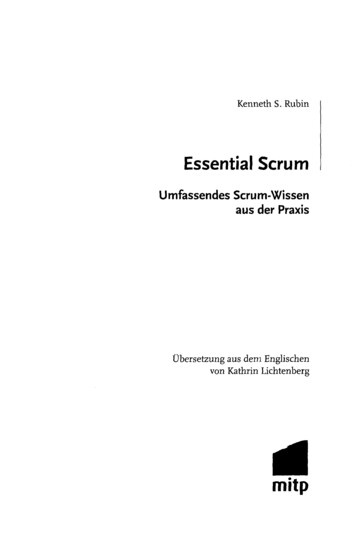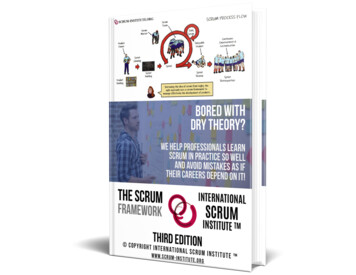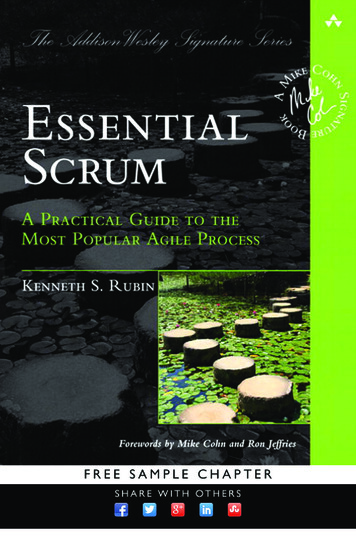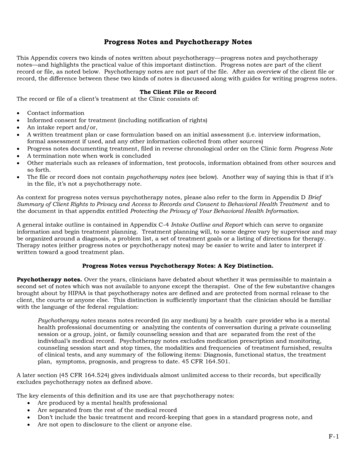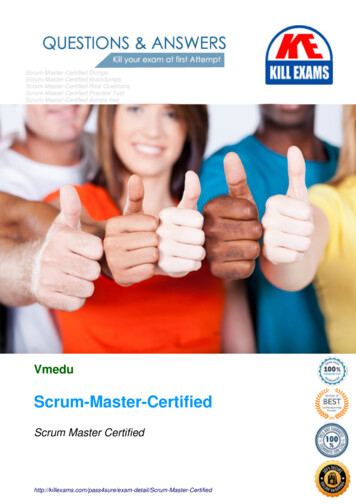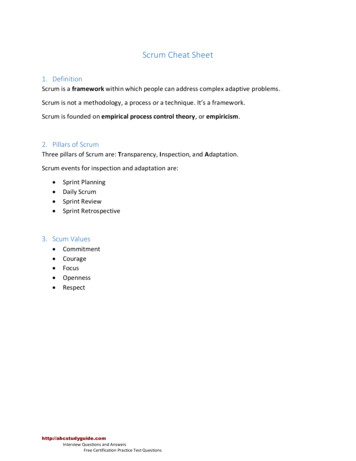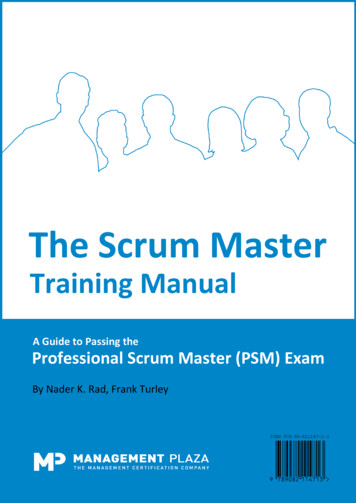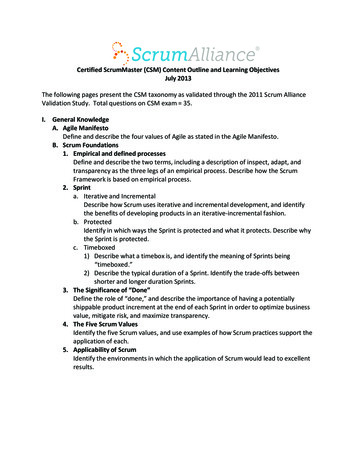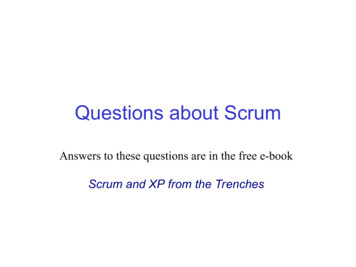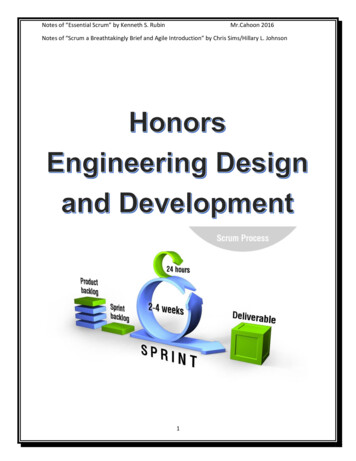
Transcription
Notes of “Essential Scrum” by Kenneth S. RubinMr.Cahoon 2016Notes of “Scrum a Breathtakingly Brief and Agile Introduction” by Chris Sims/Hillary L. Johnson1
Notes of “Essential Scrum” by Kenneth S. RubinMr.Cahoon 2016Notes of “Scrum a Breathtakingly Brief and Agile Introduction” by Chris Sims/Hillary L. JohnsonContentsScrum Roles:. 3Product Owner . 3ScrumMaster. 3Development Team. 3Scrum Activities/Artifacts: . 3Product Backlog: . 3Sprints: . 4Sprint Planning . 4Steps to Plan Sprint: . 4Sprint Execution . 5Daily Scrum . 5Done: . 5Sprint Review . 5Dual Purpose: . 5Sprint Retrospective. 5Tool Specifics:. 6User Stories: . 6Format:. 6Stories can be considered: . 6Good stories INVEST . 6Story Mapping: . 8Product Backlog Items (PBI) Estimating . 8Planning Poker . 9Velocity . 92
Notes of “Essential Scrum” by Kenneth S. RubinMr.Cahoon 2016Notes of “Scrum a Breathtakingly Brief and Agile Introduction” by Chris Sims/Hillary L. JohnsonScrum Roles:Product Owner: Main person for product leadership.-Decides which features and functionality are needed, and in what order they wantthem built/developed.Responsible for overall success of solution build and maintenance.Collaborates with ScrumMaster and Development Team to answer questions andensure focus of project.ScrumMaster: (Team Leader) Helps team adjust to issues applying Scrum and make-improvements in application of Scrum.Takes control of resolving team issues when the members of the team cannotreasonably resolve them, themselves.NO AUTHORITY to exert control of over the Team; rather is a mentor, NOT aManager.“The Scrum Master acts as a coach, guiding the team to ever-higher levels ofcohesiveness, self-organization, and performance The Scrum Master helps the teamlearn and apply scrum and related agile practices to the team’s best advantage. TheScrum Master is constantly available to the team to help remove impediments androad-blocks that are keeping them from doing their work. This is a peer position onthe team, set apart by knowledge and responsibilities, not rank”.1Development Team: “Diverse, cross-functional, collection of people who are responsible fordesigning, building, and testing a desired product”2.- Typically 5 – 9 people- Collective talents of its members capable of producing good-quality-workingproduct.- Team members change their mentality using Scrum to a “mindset change from‘doing my job’ to ‘doing the job’. It is also a change in focus from ‘what we aredoing’ (work) to what is getting done (results)”3Scrum Activities/Artifacts:Product Backlog: A large list of requirements is “groomed” by the Product Owner (afterconsulting with the ScrumMaster and Development Team), into a set of prioritized features,called the Product Backlog and referred to as Product Backlog Items (PBIs).123Simms and Johnson, Scrum: A Breathtakingly. (Dymaxicon: 2014)Kenneth Rubin, Essential Scrum (Addison-Wesley: 2013), 13-28)Simms and Johnson, Scrum: A Breathtakingly3
Notes of “Essential Scrum” by Kenneth S. RubinMr.Cahoon 2016Notes of “Scrum a Breathtakingly Brief and Agile Introduction” by Chris Sims/Hillary L. JohnsonInitially contains the features needed to meet the product owner’svision.-As process ensues, may also contain additions of new features,changes to existing features, defects needing repair, technicalimprovements, etc.4-Considerations for value, cost, knowledge and risk: Highest value items attop of the list – lower value items at bottom of list.-Constantly changing by product owner as business evolves or with input ofScrum team.Sprints: Work is completed in small cycles lasting up to a month; usually 2-4weeks. Work completed for each sprint creates tangible product forProduct Owner.-Sprints are “timeboxed”: fixed start and end sate, and duration isconsistent for all sprints.-Next sprint begins immediately following end of previous sprint.-Do not alter scope of what is expected to come out of sprint, once itbegins. Development Team responsible for reaching goal.Sprint Planning: Completing a project requires several sprints. Product Owner,ScumMaster, and Development Team agree on a goal of the sprint.-Sustainable Pace: “a pace at which the Development Team cancomfortably work for an extended period of time”5.-Subtasks of a single Sprint are called the Sprint Backlog.These items are then prioritized and organized withassignment of values (1, 3, 5 point items). These numerical assignments,represent the amount of time and resources that the Development Team assumeswill be required to complete each subtask (1 being less time and 5 being moretime).Steps to Plan Sprint:1. Select a product backlog item (preferably next most important).2. Break that item into subtasks.3. Determine if subtasks will reasonably fit in the sprint timeframe. If there istime, then assess if there are more tasks to be added to the sprint. If so, repeat45Rubin, Essential Scrum, 18.Rubin, Essential Scrum, 22.4
Notes of “Essential Scrum” by Kenneth S. RubinMr.Cahoon 2016Notes of “Scrum a Breathtakingly Brief and Agile Introduction” by Chris Sims/Hillary L. Johnsonthis process, until the team agrees that they sprint is full, for working at asustainable pace.Sprint Execution: Once sprint planning is complete, the team (with guidance from the ScrumMaster) self organizes, prioritizes the tasks in the Sprint, and ensures that at theend of the Sprint, they are “Done” (Done completed all work necessary topresent finalized feature to Product Owner).Daily Scrum: Begin each day with timeboxed Daily Scrum – aka “stand-up”. All memberswill stand in a circle and cover the followingthree points:-What have I done since the last daily scrum?-What will I do by the next daily scrum?-What are my obstacles or impediments that are preventingme from making progress?This is not a time for questions or judgement. If members of the Development Team heara group member indicate an issue they are having, that they feel they can contribute asolution to, then they will approach the team member having the issue, after the stand-up,for collaboration.Done: It is imperative that the entire Development Team, ScrumMaster, and Product Ownerhave an agreed upon definition of “Done”. For the purposes of this course, “Done”means completed, edited and in “shippable product” format. In other words – it is in afinal draft mode, having been checked, double checked and edited by the DevelopmentTeam and ScrumMaster, fully.Sprint Review: The first “inspect-and-adapt” activity6. The goal is to inspect thejust-completed feature(s) and discuss what is occurring, and to help guide theupcoming Sprint Plan.Dual Purpose:-Non Development Team members are able to get updated on the effort and helpguide it.-The ScrumMaster and Development Team are given insight from an outsideperspective to ensure that it is going in the appropriate direction of a successfulproduct to the end-user.Sprint Retrospective: The second “inspect-and-adapt activity. This occurs after the sprintreview and before the next sprint is planned. The goal of the sprintretrospective is to evaluate the sprint PROCESS being implemented.This review is done by the ScrumMaster, Product Owner, and6Rubin, Essential Scrum, 26.5
Notes of “Essential Scrum” by Kenneth S. RubinMr.Cahoon 2016Notes of “Scrum a Breathtakingly Brief and Agile Introduction” by Chris Sims/Hillary L. JohnsonDevelopment Team, in order to identify, evaluate, and correct areas thatcan improve the overall performance and flow of the Scrum team.7Tool Specifics:User Stories: Are also known as Product Backlog Items (PBIs)8. Each PBI represents adifferent business value (design criteria). Rather than setting the designcriteria rigidly in the beginning of the project, when we may not have all of theinformation that we will need to make a successful product, we create theseinitially slightly more general user stories, for each criteria. As we get closer tothe need for more detail, then we begin finer defining of that User Story, toensure (best we can for that iteration) that we are achieving what the customerwants/needs in that feature, for it to be successful.Format: To be written on a 3x5 notecard in the following format: “As a user role Iwant to goal so that benefit . Sample: “As a typical YELP user I want tosee unbiased reviews of a restaurant near an address so that I can decidewhere to go for dinner.”9 The back of the card should have the ‘conditions ofsatisfaction’. Essentially, this is a checklist that if all aspects areachieved, will verify that the user story has been met.User Stories should be supplemented with whatever documentation and writteninformation that helps to provide clarity regarding what is desired (engineeringnotebook entries that summarize a conversation with a customer, otherDevelopment Team members, or based on research (online or in person).Stories can be considered:-Epics: covering several months-Features: covering several weeks, and unable to achieve in single sprint,orSprintable/Implementable Stories: days in size and are ableto be covered in a single sprint.-Good stories INVEST: Independent, Negotiable, Valuable, Estimatable, Small, andTestable.Independent: for the most part, we do not want our stories to be toointerdependent on other stories. This can cause a slowdown in progress, waitingfor one sprint to be completed, because of another.Negotiable: They ARE NOT detailed requirements, rather they allow fordiscussion and modification. “Capture the essence of what functionality is desired7Rubin, Essential Scrum, 28Rubin, Essential Scrum, 809Rubin, Essential Scrum, 8286
Notes of “Essential Scrum” by Kenneth S. RubinMr.Cahoon 2016Notes of “Scrum a Breathtakingly Brief and Agile Introduction” by Chris Sims/Hillary L. Johnsonand why. However, they leave room for the team and stakeholder to negotiatedetails.”10Stories should be about what and why, not how. The how is what allows teams tomodify, adjust and re-approach from a different perspective (innovate).Estimatable: This allows the story to have a size estimate made by the team. Italso helps to establish if the story is too large that it may be too ambiguous andneed to be broken into smaller stories. If the story cannot be estimated, it maymean that the team does not have enough knowledge to estimate. At this point, theteam needs to plan an exploratory activity to learn more.11Sized Appropriately (Small): Several stories should be worked-on in a single sprint.So, stories must be small and achievable in a few days. You will assign pointvalues to your various stories, but keep in mind that the goal is to COMPLETE thestories for that sprint, in that sprint, and NOT CARRY OVER to next sprint. Thisis an “all hands on deck” approach to get things accomplished very quick
Notes of “Essential Scrum” by Kenneth S. Rubin Mr.Cahoon 2016 Notes of “Scrum a reathtakingly rief and Agile Introduction” by hris Sims/Hillary L. Johnson 3 Scrum Roles: Product Owner: Main person for product leadership. - Decides which features and functionality are needed, and in what order they want them built/developed.
